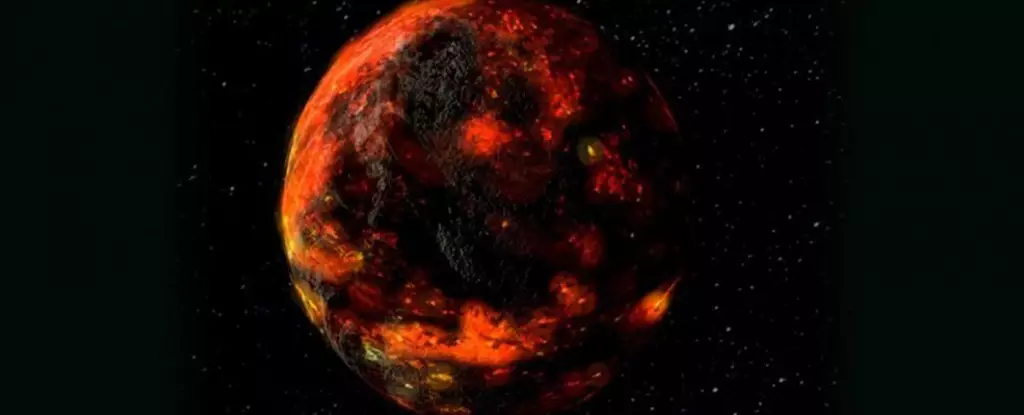Understanding the origin and subsequent development of our Moon remains one of the compelling quests of planetary science. Though significant details about its surface and geological composition have been amassed chiefly through the Apollo missions, numerous enigmas about its early history persist. Recently, groundbreaking research conducted by a team at the University of Chicago, led by scientist Nicolas Dauphas, has added crucial information to our understanding of the Moon’s formation timeline, unveiling how it solidified approximately 4.43 billion years ago— almost contemporaneously with Earth’s transition into a habitable environment.
The early ancestry of the Moon is marked by dramatic events that shaped not only its structure but also the very formation of our Solar System. The prevailing theory suggests that the Moon originated following a colossal impact event, in which a Mars-sized body, dubbed Theia, crashed into the primordial Earth. This cataclysm produced a vast cloud of molten debris that subsequently fused to create the Moon. Initially, the lunar surface existed as a homogenous, molten mass.
Over time, as this molten “proto-Moon” began to cool, it underwent a process of crystallization and stratification. This led to the formation of distinct layers within the Moon, as materials segregated based on their densities and melting points. Eventually, a predominant part of the lunar magma ocean solidified, with only about 1% remaining as a peculiar residual liquid known as KREEP— an acronym for potassium (K), rare earth elements (REE), and phosphorus (P). This KREEP layer symbolizes a significant remnant from the Moon’s formative stage and offers vital clues about its evolution.
Dauphas and his research team delved into the compositions of lunar rock samples to study KREEP’s characteristics. Their findings reveal that KREEP crystallized approximately 140 million years after the Solar System’s birth, providing a new temporal anchor for lunar studies. Identifying this unique composition in the rock samples from the Apollo missions, scientists anticipate additional discovery from lunar exploration missions such as Artemis, particularly in the South Pole-Aitken basin. If KREEP is found there, it could suggest a widespread and uniform distribution across the Moon’s surface, a finding that would fundamentally enhance our understanding of its geologic history.
Using Rare Elements to Trace Geological History
An intriguing aspect of this research hinges on the behavior of lutetium, a rare earth element that decays into hafnium over time. This decay process is particularly useful for age-dating rocks, as it implies that all celestial bodies formed around the same time would contain comparable ratios of these elements. However, the decay signatures found in lunar samples suggest a different story. The composition of lunар rocks indicates a scarcity of lutetium in contrast to other contemporaneous materials, leading scientists to undertake a detailed investigation into the proportions of these elements.
Through meticulous analysis, the researchers determined that regions within the Moon formed in the context of KREEP reservoirs are aligned with ages consistent with their calculations. With this more precise methodology, the team established that KREEP solidified roughly 4.43 billion years ago, which adds a compelling chapter to the Moon’s geological history.
Diving deeper into the timeline, the implications of KREEP and the lunar cooling process extend beyond the Moon’s history. The Moon’s formation and its subsequent geological changes coincide with significant events happening on Earth. Predominantly, these changes stem from the bombardment of leftover planetary debris while the Moon was solidifying—essentially continuing the chaotic narrative of our Solar System’s early years. This period is thought to be pivotal not only for the Moon but also for shaping Earth’s own atmospheric and geological evolution.
The impacts that built the Moon and its subsequent geological features could mark the end of the chaotic formative phase for Earth, leading to the establishment of more stable conditions. This stability would ultimately lay the groundwork for the development of a habitable environment conducive to life.
Looking Forward: The Next Generation of Lunar Research
Scientists are eager to fill in the gaps in our understanding of the Moon’s history through continued exploration. The upcoming Artemis missions, combined with findings from China’s Chang’e expeditions, are expected to provide additional rock samples from the Moon’s surface, particularly the South Pole-Aitken basin. The new data could further elucidate the lunar cooling timeline, helping to identify how and when specific geological formations like mare basalts were created.
As researchers like Dauphas continue to decode the Moon’s enigmatic past, they illuminate the greater narrative of our Solar System’s evolution and our planet’s place within it. Ultimately, this research not only enriches our understanding of the Moon but also contributes valuable insights into the prehistoric dynamics that shaped Earth into a habitable planet. With each new discovery, we come closer to unraveling the intricate tapestry of cosmic history that connects us to our celestial companion.

